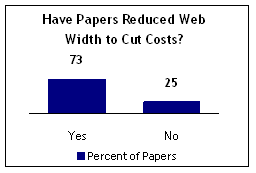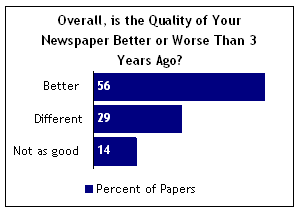
In part, this report is a portrait of how those papers are pushing the boundaries of innovation at a pace unthinkable a decade ago. At the same time, however, it documents the crippling impact of cutbacks triggered by the erosion of once-solid financial fundamentals. As we noted in introducing our findings, these two contradictory forces have effectively placed newspapers in a race—a race between innovating and cutting back. How quickly can newspapers invent a new journalism online, build an audience and find a way to monetize the product? And in the time it takes to do this, how much will further staff losses, and the accompanying loss of institutional memory and community knowledge, undermine their biggest competitive asset—the size and strength of their newsrooms? How much will they have to cut back on key subject matter? Will audiences drift away because their old economic model is shrinking more quickly than their new one is growing? Or will the investment in new technologies generate the income needed to sustain staffs large enough to produce outstanding journalism? Winning this race, editors sense, involves innovating quickly—on both business and editorial sides of the paper—with one hand and fighting off excessive cut backs with the other.
The $64,000 Question: How to Monetize the Web?
In interviews, many were optimistic. Some, for example, argued the ability of technology to track readership of specific stories has given editors a powerful weapon in future financial battles, for the first time making an indisputable link between strong editorial content and the kind of higher readership that attracts advertisers. Now, editors stress, their colleagues must use this connection in financial battles.
“Too many editors are great with anecdotal stories but they don’t really measure what’s working and what’s not,” said Kansas City Star’s Zieman, who earned an MBA last year while still editor specifically to arm himself for the financial battles to come. “If you don’t know the numbers you won’t be invited to the table where these decisions are made.”
Convincing newspaper advertising sales staff to become more active in selling to the web is also viewed as an essential, overdue step, even if it’s not easy. Roughly 90% of advertising sales remain with the print media. In interviews, newsroom executives complained that advertising departments traditionally have been far more resistant than their editorial counterparts to the changes brought by the Internet Age. Understandably, there is less incentive to go after a pot containing 10% of the revenues than to go after one with 90%. But some editors warn that if advertising staffs don’t shift their focus now, they could end up with nothing in a matter of years because there would be no print edition left.
Still, there are signs of progress, at least anecdotally. The Journal-World, for example, has developed a software called Marketplace for potential advertisers that blends the format of electronic yellow page-type directories with strong, local community knowledge, offering local companies the ability to post commercials, profiles and other information, including store hours and photos, and coupons. In its first six months, developers claimed a single ad salesperson in a relatively small market brought in nearly one-half million annualized dollars, mainly from advertisers who had not previously done business with the paper.
The trick, said Dan C. Simons, Electronics Division president of The World Company, publisher of the Journal-World, was the neighborhood focus of the advertising.
“If we can make $450,000 in six months, Chicago can make $20 million. It’s completely scalable,” said Simons. Programmers are currently working on a point of sale inventory, enabling a potential customer to check online if their local store has a specific product in stock.
Lowering the Wall
One implication of running in this race, editors told us, is that the once-formidable wall that divided the news and business sides of the newspaper has been substantially lowered. While that may not mean business people are roaming the newsroom influencing the product, there is evidence it does mean that the news people are busy trying to imagine new ways of making money.

Fully 97% of editors responding to the survey said they were active, at least to some degree, in the search to develop new revenue streams. One editor noted how his paper had offered a premier investigative package for sale on Amazon.com.
At papers both large and small, this has included launching tabloid sections aimed at specialized audiences. Over half those surveyed (55%) said they had launched new tabloid products, usually narrowly targeted to youth, minorities or other specific demographic groups. Just over four in ten (42%) said they had re-launched existing broadsheet sections or editions in tabloid format.
Is this lowering of the wall bothering editors? Less than some might have imagined. Among larger newspapers – e.g., those under greater financial strain—a majority of editors surveyed (57%) said they were either “not very concerned” or “not at all concerned” about lowering this wall in search of new revenues, while just 41% expressed worry. At smaller papers, the level of concern is higher. Fully 63% of editors surveyed were concerned about the lowering of the wall, while just 35% said they were not overly worried.
In interviews, several editors said they encouraged discussions between the two departments to a degree they had not done previously, with one admitting, “I never thought ten years ago that I’d be suggesting some of the things that I have.”

But the survey results suggested a sense of disillusionment among newsroom executives that their organization has been slow to recognize and adjust to a new business climate. Only a small minority (14%) of those responding to the survey agreed with the notion that their organization had anticipated and planned “very effectively” for the changes needed to remain competitive.
In addition to reducing staff and newshole, newspapers have also tried to cut costs other ways. Chief among them is efforts to economize on newsprint, a step that has taken on added urgency with a steady rise in newsprint prices that began last fall and at mid-year stood at their highest levels in over a decade. Today, the newsprint is thinner than it was a few years ago and newspapers are actively reducing the number of pages to counter the cost increases. Tribune Co., recently announced it planned to cut as many as 500 pages per week from the Los Angeles Times. And, as a metaphor of the times, the physical size–the so-called web width—of America’s daily newspapers is shrinking. Nearly three-quarters (73%) of those editors participating said their papers had reduced web width in the past three years as a newsprint cost-saving measure.
A Stubborn Optimism
In the end, one of the key elements determining the race’s outcome will be how well the quality of the journalism produced in America’s daily newspaper newsrooms can be sustained and whether the people who run these newsrooms have a vision for the future.

When it comes to the first of these questions, the quality of the work, many of the editors express a remarkable—at times almost eerie—optimism despite the adversities they have faced. In general, the editors we talked to tend to look beyond what their newsrooms have lost in recent years and instead focus on the new vistas that technology has suddenly opened to them and the new energy and purpose of a faster-moving newsroom. In interviews, a majority of editors said that, on balance, they believed the journalism produced by today’s smaller newsrooms was as good or better than a few years ago.
Survey responses reflected this same view. By sizable majorities, editors rated the accuracy, depth and comprehensiveness of the newsroom’s reporting and the quality of its writing as good or better than three years ago. Despite the cutbacks in staffing and space, by 54% vs. 32%, clear majorities of editors said the comprehensiveness of their news coverage had either significantly or somewhat improved, despite the cutbacks, in the last three years. By a 58% vs. 25% margin, editors also thought “the depth of their newsrooms” reporting had improved. A majority of editors (53%) also thought their paper’s writing had improved, despite the shift toward younger staff. An overwhelming 94% of editors said their papers were as accurate or more accurate than three years ago. And a solid 56%, taking it all in, said the “overall quality of their news product is now better than it was before.”
Kaiser of the Milwaukee Journal Sentinel, agreed that “less could never be more,” when it came to newsroom size, but said he too was convinced his paper was stronger despite the loss of 20 newsroom staff positions over the past two years. The Journal Sentinel recently was awarded the 2008 Pulitzer Prize for local reporting.

“Let’s say we’re better focused, we do better projects,” he said. “We have to talk about the newsroom, not just the paper because we produce the website and other things, too.”
David Wilson, Managing Editor/News of Miami Herald, a paper that has seen its circulation and the size of its newsroom staff decline sharply in recent years, echoes Kaiser’s comment: “Through all that’s happened over the last few years, the quality of our work is among the best I’ve seen—and I’ve been here 31 years.”
How can this be? One explanation is just what editors have said—crisis has focused their thinking and made them sharper. Another factor may also be psychology. These are the editors who remain, who are facing this challenge. As newsroom leaders, their job is to build staff morale and combat defeatism. A sense of optimism is essential in doing that. On top of that, they are working hard, innovating, making changes. They may have fewer reporters and less space to work with, story by story, they are certain that what they are producing today is better than what they produced a few years ago.
Uncertainty
Despite all this, editors were far less certain an improved editorial product would be enough to guarantee a bright future. Doubts about their organization’s ability

to make the changes needed to remain competitive were especially noticeable among those whose organizations had failed to anticipate change effectively in the past. Among this group of editors, only 28% thought their organizations were up to the task. By contrast, among editors who believe their organizations were somewhat, or very, effective in the past in anticipating changes, 63% expressed confidence they would again take the right steps
When asked directly about their own confidence in imagining the future, editors seem cautious and only marginally more confident than not. Only 5% say they can predict with any certainty what their newsroom will look like in five years. Another 46% said they were “somewhat confident” in their ability here, but an equal number (46%) said they were either “not very confident or not confident at all.”
In the face of such uncertainty, several editors cited their staff’s willingness to accept change and embrace new technology as the factor contributing most to their competitiveness. “Flexibility,” summed up one newsroom executive.




